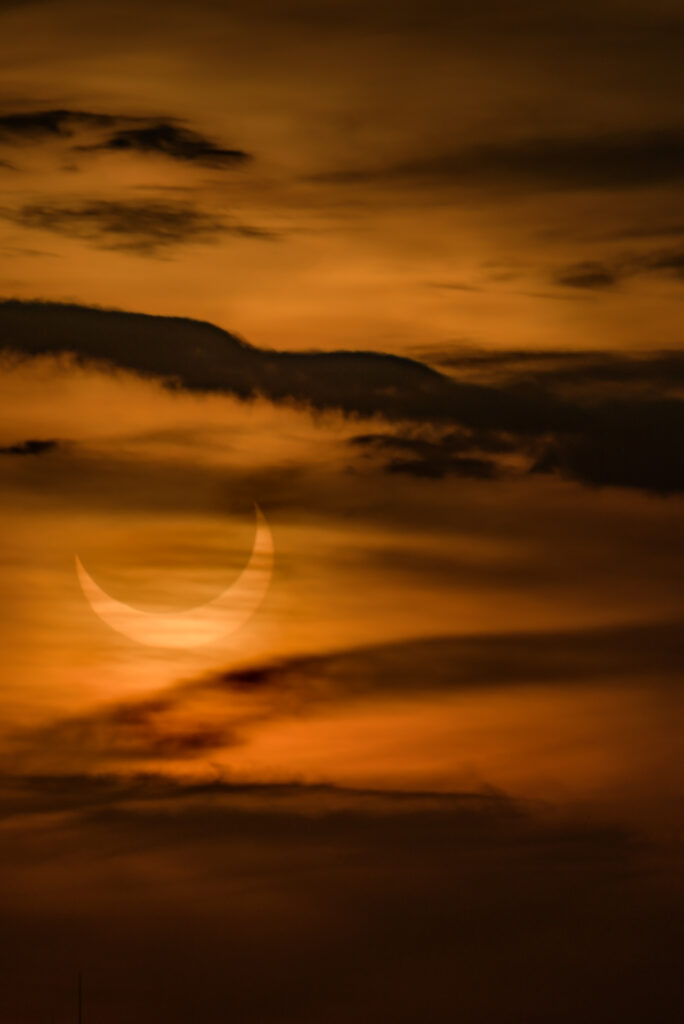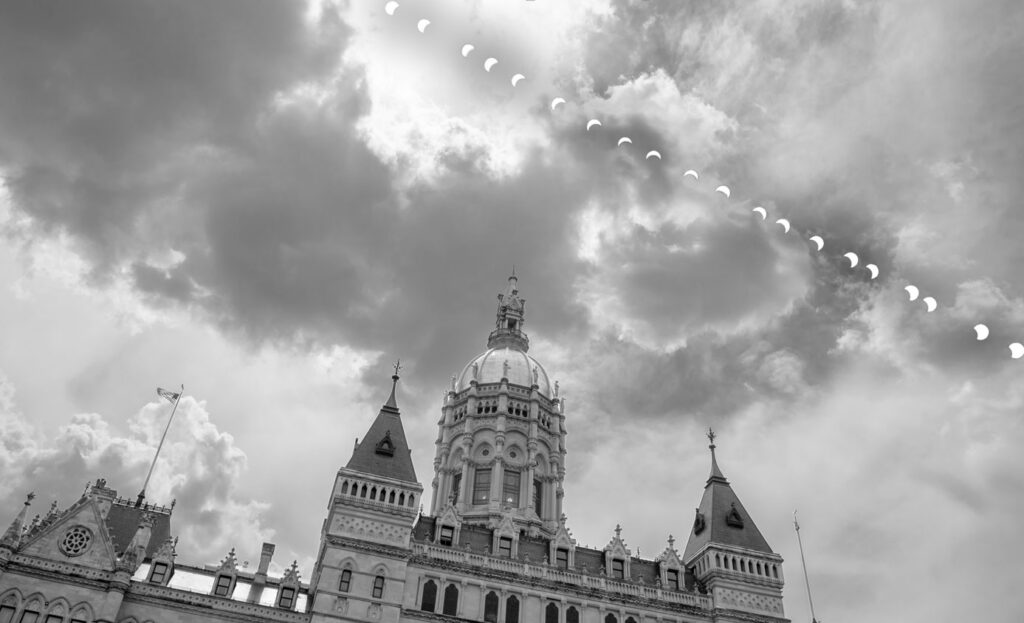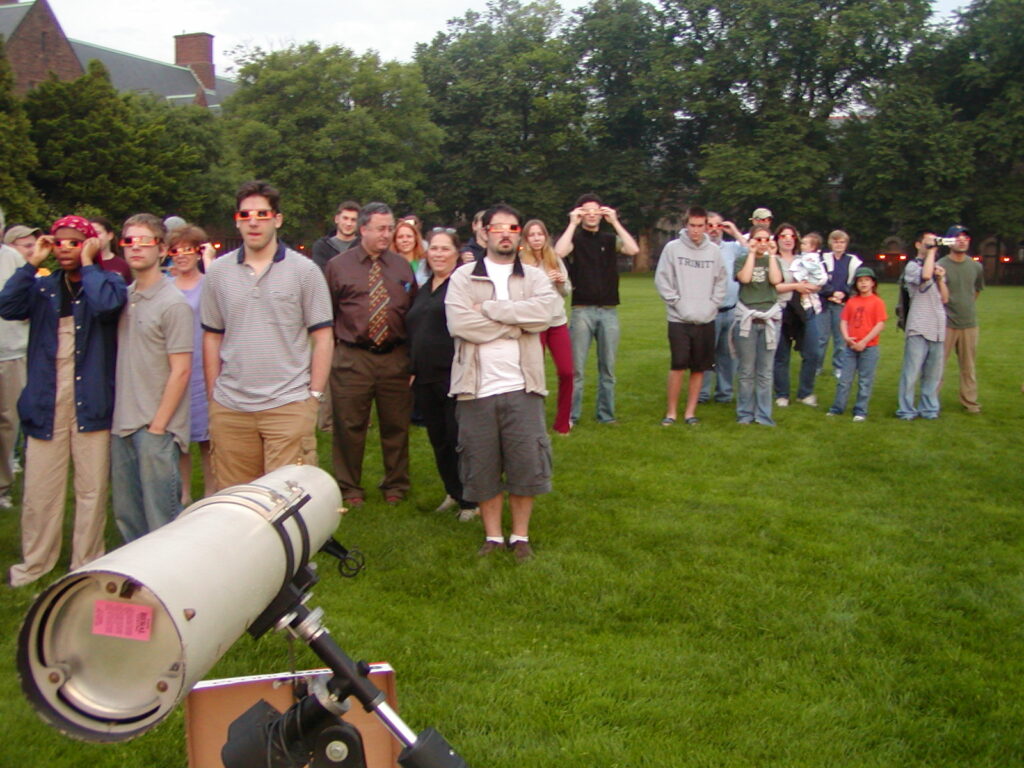There Goes the Sun: Solar Eclipse Should Be ‘A Really Awesome Show,’ Physics Professors Say
Trinity College’s campus will experience a dusk-like darkness on the afternoon of Monday, April 8, when the moon blocks out most of the sun’s light during a partial solar eclipse.
While Hartford will not see a total eclipse, more than 90 percent of the sun will appear covered. “It will still be quite impressive,” said Assistant Professor of Physics Kelly M. Patton. The path of totality—where the moon completely blocks the sun for several minutes—will track farther north, traversing parts of New York, Vermont, New Hampshire, and Maine.

Associate Professor of Physics Barbara Walden said that the eclipse will last approximately two and a half hours, but the most interesting part is around the midpoint when there will be maximum coverage, which happens at 3:25 p.m. in Hartford. “The sun will be fairly high in the sky and it won’t be hard to see on campus,” Walden said. “The dimming of the sun in the middle of the day will be a pretty unusual experience, even if it’s cloudy that day.”
An eclipse occurs when the moon crosses directly between the sun and the Earth. “The Earth is orbiting the sun, and the moon is orbiting the Earth,” Patton said. “By random happenstance, the size of the moon in our sky is about the same size as the sun in our sky, so when the moon passes in front of the sun, if you’re at the right angle, the moon completely covers the sun and you get a total eclipse. Every now and then, some of the ways that physics works seem too good to be true, and yet, there it is.”
Patton is currently teaching the course “Relativity and Fundamental Particles,” which includes a well-timed connection to solar eclipses as they relate to Einstein’s theory of relativity. “One way to test that theory early on was to observe solar eclipses, to prove the concept that light gets bent by gravity,” Patton said. “This fact that light bends around stars and galaxies is used today by Hubble and Webb and all the big telescopes as a way to observe far-distant galaxies.”
The path of totality is fairly narrow across the Earth’s surface, according to Walden, who has developed several courses in astronomy at Trinity. “Whereas lunar eclipses are visible throughout most of the Earth, solar eclipses are not,” said Walden, highlighting the rarity of this occurrence. “The moon is actually making a shadow on the Earth, and the shadow that passes over parts of the Earth is really tiny.”

Safety should be every observer’s priority when viewing the eclipse. “You never want to look directly at the sun without the proper eye protection,” Walden said. “Any time you look at the sun, you can burn the retinas or damage the corneas of your eyes.”
Walden added that special eclipse glasses that are safe for viewing are quite opaque over a large portion of the light spectrum. “You cannot use regular sunglasses,” she said. “When you look through eclipse glasses, you shouldn’t be able to see anything except for a very bright light source.” After receiving inquiries from students, Walden ordered 300 pairs of eclipse glasses to distribute.
There are other ways to observe the eclipse without special glasses, Walden explained. “In areas of dappled shade under trees, you’ll notice projections of the eclipse. The tiny spaces between leaves where the light gets through act as pinhole cameras and make images of the sun on the ground. It will be quite fabulous because you’ll be able to see all these little projections of the sun, and they’ll be in the eclipse shape. It will be quite distinctive,” Walden said. “You can create this yourself, too, by making a tiny pinhole in a large piece of aluminum foil and holding it up high to get a good-sized projection. You can make a tiny projection using a gap between your fingers as well, and some people even use strainers or colanders.”
One reason why people find eclipses so interesting is that when the sun’s bright surface is blocked out during totality, they can directly observe the sun’s corona, or outer atmosphere, Walden said. “We’re in an active period of the sun’s solar cycle, which may mean that the corona could be quite spectacular,” she said. “Sometimes you see globs or jets of plasma thrown off the surface of the sun, due to complicated magnetic fields.”
Patton agreed, “What makes this eclipse a little special is that the corona may be even more impressive and dramatic than usual. If you have the right glasses, you might be in for a really awesome show.”

The physics faculty members encouraged all members of the Trinity community to experience the eclipse—weather permitting—as another one like it will not be visible in the United States until 2044.
Walden suggested visiting the website timeanddate.com for more information about the timing and path of the April 8 solar eclipse.
The 200-year history of the College includes several other connections to astronomical events, including the transit of Venus in 1882, when a German commission sent a team of astronomers to campus to observe Earth’s neighboring planet cross in front of the sun. A stone plaque commemorating that transit and visit is located at the edge of the McCook Academic Building patio. More than a century later, the 2004 transit of Venus attracted hundreds of observers to campus.
Trinity also was once home to the St. John Observatory, and over the years has been the location of several sundials, at least two of which still stand today.
